USk Reportage Grant Projects 2023
ビジュアル・ストーリーテリングは、USk運動の中核をなすものです。アーバンスケッチャーのルポルタージュ助成プログラムは、ある出来事をとらえ、その背景、人物、設定を示すことによって物語を語る世界中の物語に焦点を当てます。その地域の文化、時間、産業/貿易、社会の変化などの一面に焦点を当て、絵と文章で表現しています。このプログラムは、私たちのコミュニティにおけるドローイング・ルポルタージュの最良の例に焦点を当て、新しい世代のアーティスト・レポーターを刺激することを目的としています。
We are happy to present the final projects that were completely through 2023.
Old New Villages by Gan Aaron
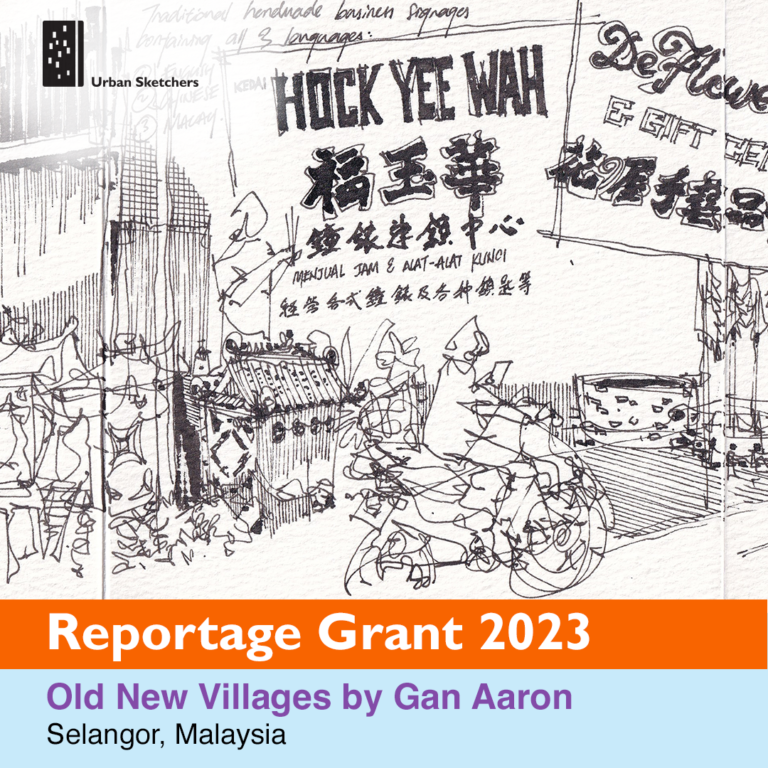
In Gan Aaron’s recent reportage project “Old New Villages,” he delves into the rich cultural heritage of Malaysia’s rural landscapes. Funded by the USK Reportage Grant, Gan’s project focuses on documenting the transformation of 12 former new village sites in Selangor, Malaysia. These once-isolated settlements, established during the British colonial era, are now undergoing rapid rejuvenation efforts to become bustling tourist destinations.
Beginning his urban sketching journey just two years ago, Aaron’s exploration of these vibrant villages was as much a search for his roots as his style. Aaron’s sketches serve as a visual chronicle of their past, present, and uncertain future.
12 ‘New’ and evolving villages in 9 days
The word ‘new’ in the term ‘new village’ (Malay: kampung baru / Chinese: 新村), does not represent a sentiment of being ‘recent’. The term was introduced by the British colonials of Malaya peninsula in the 1950s. Making the ‘new’ now part of Malaysia’s heritage.
Gan embarked on his journey through 12 of these ‘new’ villages, armed with nothing but a sketchbook and fountain pens. He immersed himself in the local culture, forging connections with villagers and capturing their stories through his art. From bustling morning markets to tranquil village streets, each sketch reflects a moment frozen in time, preserving the essence of these evolving villages.
Sketching to reflect on tradition and progress
Through Gan’s sketches, viewers are invited to explore Malaysia’s cultural landscape and reflect on the delicate balance between tradition and progress. As Gan puts it delicately:
“Whenever I loiter around the villages after sunset with my sketches in hand, reminiscing all that happened throughout the day, I accepted that the intricate way of life in all new villages would soon change or be gone one day. I used to perceive this as unnecessary developments that require interventions to preserve it as is. Yet after seeing with my own eyes, I now believe it as a natural change that is necessary over the change of time. As urban sketchers, we would record while time still permits, preserving what we think is essential in our own language with pen on paper, in analogue or digital.”
Inside the French Parliament by Marielle Durand
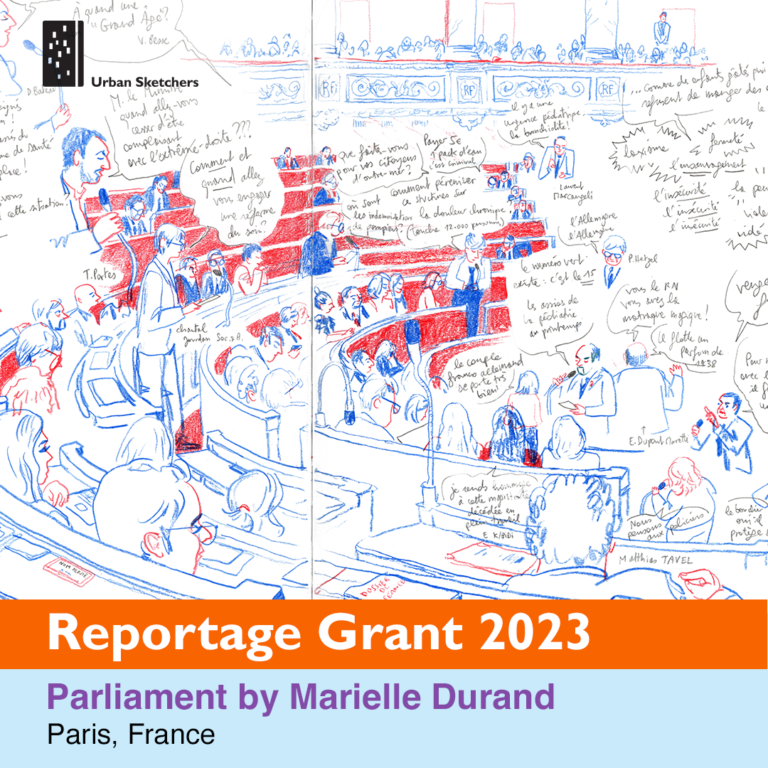
Paris based urban sketcher, Marielle Durand, is known for her mastery of light and intimate portraits of people and places. In her new project “Inside the French Parliament,” for which she received a USK Reportage Grant, she offers a poignant glimpse into the heart of democratic governance through vibrant sketches and insightful commentary.
How it started
In October 2022, Marielle found herself among a select group of artists granted unprecedented access to the inner workings of the French Parliament. This historic moment marked the official recognition of professional artists’ right to document parliamentary debates through art.
With her trusty red and blue color pencils in hand, Marielle delved into the heart of the parliamentary process, capturing the essence of discussions during the “Questions au Gouvernement” sessions. From the iconic “Hemicycle” to the lesser-known corners of parliamentary life, her sketches breathe life into the political landscape.
The colors of the flag
Marielle’s choice of red and blue as her primary colors not only pays homage to the French flag but also symbolizes the fervor and dynamism of political discourse. Through her art, she aims to demystify the inner workings of Parliament and shed light on pivotal moments in French political history.
Beyond documenting events, Marielle sees her project as a means of fostering understanding and engagement. By accompanying her drawings with insightful captions, she invites viewers to delve deeper into the political process and its implications.
Looking forward
As Marielle continues her journey within the walls of power, Marielle dreams of extending her project to encompass the entire legislative process, from proposal to application. With each stroke of her pencil, she brings us closer to the heart of democracy, reminding us of the power of art to transcend barriers and ignite change.
Additionally, she aspires to inspire fellow sketchers to embark on similar endeavors, creating reportages of unique places and stories, thus expanding the scope of visual storytelling in our community.
Yesterday's War: An Illustrated Journey through Bosnia by Matthew Gibbons
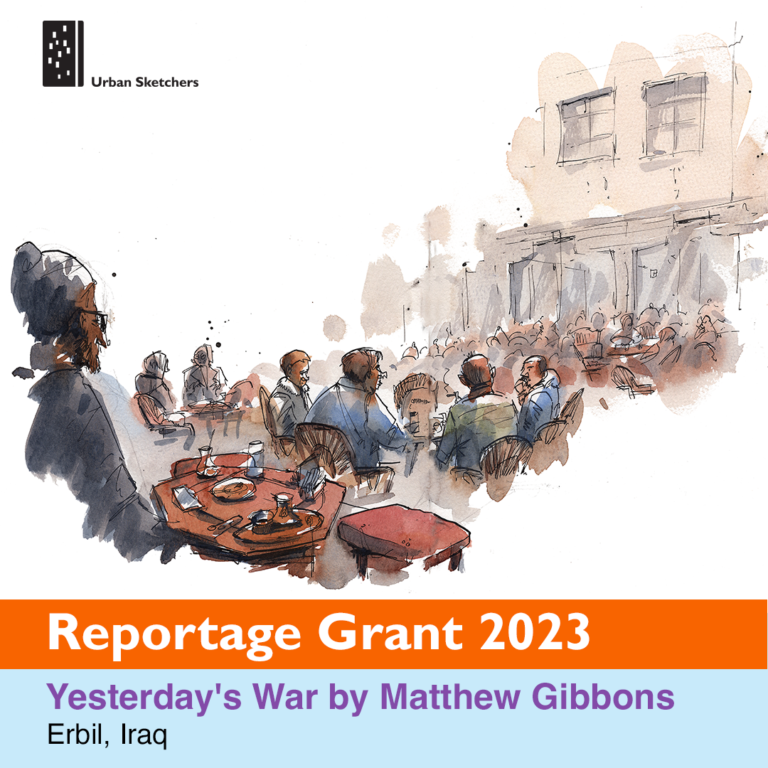
Yesterday’s War: An Illustrated Journey through Bosnia by Matthew Gibbons
Matthew Gibbons is an artist driven by not only the evocative power of watercolor and ink, but also by different aspects of society; urban living, migration and climate change. With the conflict in Ukraine dominating the European headlines, he went on a journey to the past with his project “Yesterday’s War: an illustrated journey through Bosnia.” With this reportage, for which Matthew received a USK Reportage Grant, Matthew reminds us that Bosnia serves as a reminder that the scars of war endure long after the battles have ceased.
The cost of war
Embarking on a 10-day journey through Bosnia, Matthew immerses himself in the country’s layered landscapes and past. Each illustration, from the sprawling cemeteries of Sarajevo to the bullet-riddled buildings of Mostar, bears witness to the indelible marks left by the war.
The resilience of the people
Through his art, Matthew seeks to honor the resilience of the Bosnian people and challenge viewers to confront the lingering shadows of conflict. He forged connections with locals who generously shared their perspectives and experiences. Their resilience, evident in their willingness to share their stories and guide Matthew through their communities, serves as a testament to the indomitable human spirit.
Shedding new light
Many of the sights from ruined buildings to abandoned sniper towers have been photographed countless times in news reports and history books. Yet Matthew’s reportage reminds us all that illustration and urban sketching offer added value:
These twelve illustrations do not cover the entire war. No illustration project ever could, but what I’ve aimed to do is use urban sketching and reportage illustration to observe, document and record what legacy that three-decade old war has had on the country. Many of the sights from ruined buildings to abandoned sniper towers have been photographed countless times in news reports and history books. I never intended to replace these images but to use illustration as a fresh way to order a different, perhaps slower perspective on this topic.
私の浮遊都市、カナダ北極圏とセントローレンス川(カナダ) by エミリー・グーレ
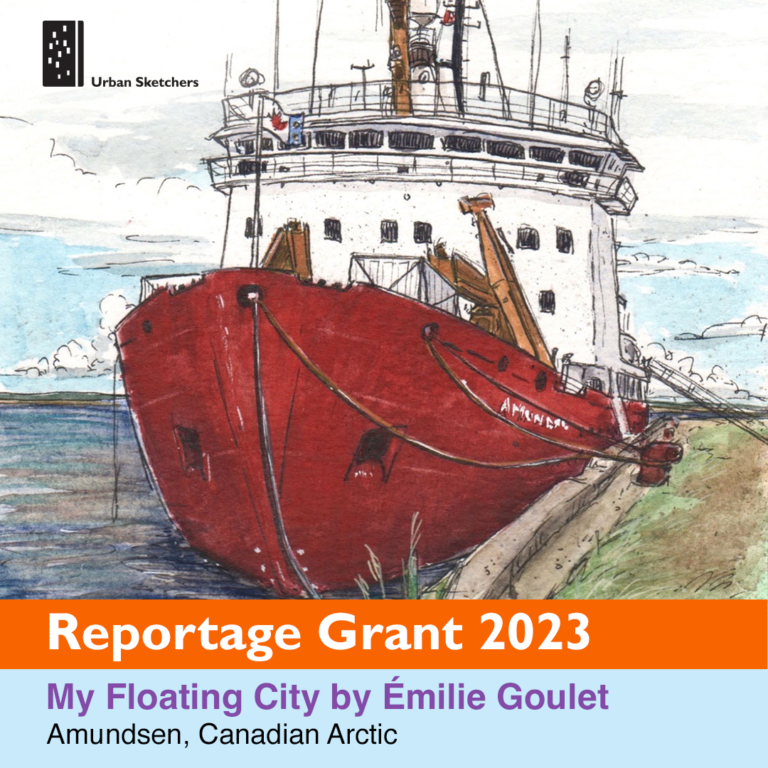
Emilie Goulet’s project, “My Floating City, Canadian Arctic and St. Lawrence River,” offers a captivating glimpse into life aboard the CCGS Amundsen, a Canadian Coast Guard Icebreaker that serves as both a vital maritime vessel and a floating community. As a navigator and urban sketcher with over two decades of experience at sea, Emilie brings a unique perspective to her reportage, capturing the daily rhythms and extraordinary experiences of life on board.
From navigating icy waters to hosting scientists conducting vital research in the Arctic, the Amundsen’s role is as diverse as its population, which ranges from 40 to 80 individuals depending on the season. Emilie’s reportage, for which she received a USK Reportage Grant, conveys an intimate portrait of this floating city, showcasing its bustling neighborhoods, communal spaces, and the camaraderie that binds its crew together.
Life on deck
Emilie’s reportage delves into various aspects of life on the ship, highlighting the intricate workings of the vessel and the challenges and rewards of maritime operations. Through her sketches, she documents the diverse roles onboard, from the deckhands maintaining the ship’s exterior to the engineers ensuring its smooth propulsion. Emilie’s firsthand experiences as part of the crew imbue her sketches with authenticity and intimacy, offering viewers a deeper understanding of life at sea.
Part of the story
Beyond providing a visual narrative of life on board, Emilie’s project underscores the value of the narrator’s perspective as an integral part of the story. As both a navigator and an urban sketcher, Emilie not only observes but actively participates in the experiences she documents. Her sketches offer more than just a glimpse into a distant world—they invite viewers to share in the journey, to feel the spray of the sea. Emilie’s project serves as a testament to the idea that the most powerful stories are often those that we live and breathe, and through urban sketching, we have the opportunity to share these stories with the world.
The Refugees Welcome North Somerset Hub Opens Its Doors by Niki Groom
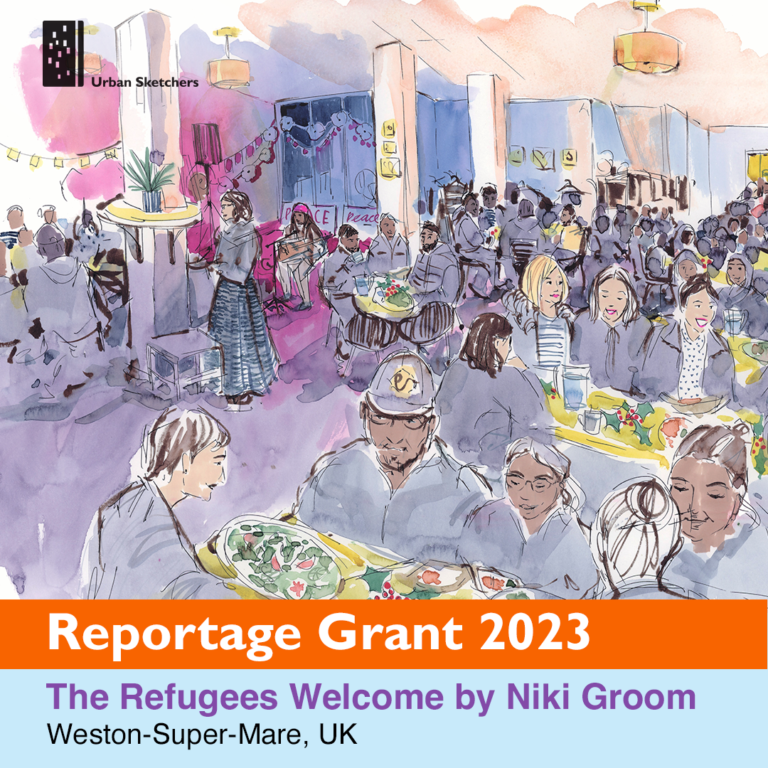
In Niki Groom’s new project, “The Refugees Welcome North Somerset Hub Opens Its Doors,” funded by the USK Reportage Grant, she paints a vibrant and heartwarming picture of community and support in Weston-Super-Mare. As a reportage artist, Niki’s sketches burst with life, capturing the energy and warmth of the RWNS Welcome Centre.
The RWNS Welcome Centre has been transformed into a hub of positivity and inclusion under the guidance of a grassroots charity. In this center families gather for homework clubs, individuals seek advice, and everyone comes together for the popular lunch club. Through her art, Niki captures the sense of belonging that permeates the space, highlighting the invaluable role it plays in the lives of refugees and the wider community.
Shifting the narrative
In contrast to the often bleak and one-dimensional portrayal of refugees in mainstream media, Niki Groom’s project offers a refreshing perspective. Instead of dwelling on the hardships, her sketches capture the resilience, strength, and vibrancy of the individuals she encounters at the RWNS Welcome Centre.
Niki’s sketches, characterized by joy, vivid colors and dynamic lines, bring life to the RWNS Welcome Centre. Through concise text balloons, she raises important issues without dwelling on negativity. She thus invites viewers to see refugees not as passive victims, but as individuals with dignity. In doing so, Niki offers a more nuanced and compassionate portrayal of the refugee experience.
A matter of engagement and trust
Niki consistently visited the RWNS Welcome Centre and talked to the people passing there: refugees, volunteers, local commerce, politicians and more. Her sustained engagement with the refugee community has earned her trust and allowed for a nuanced portrayal of their lives. By consistently showing up in the space and showing the community her work, Niki has earned the trust of the individuals she sketches. As well as documenting times of joy and community coming together, Niki was also there to capture difficult times such as people facing street homelessness and other threats.
With her reportage, she hopes to inspire other sketchers to bring a rich story, one that doesn’t form a quick conclusion or an opinion, but is instead an act of respectful observation and documentation where trust is hard to earn.
Surviving the Heat: visual stories of Saudi Arabia's summer by Kristina Matveeva
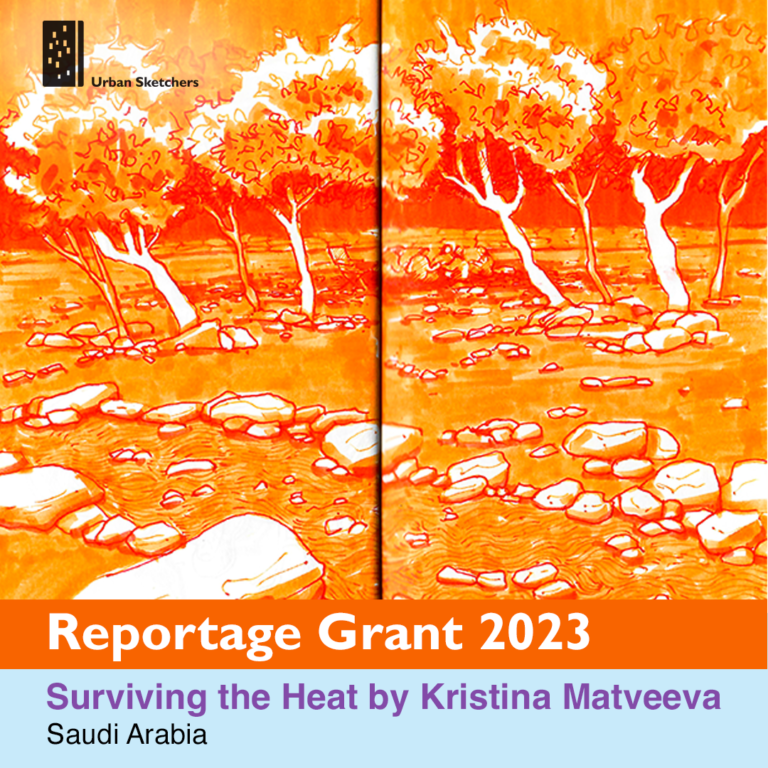
In the scorching heat of Saudi Arabia’s summer, artist Kristina Matveeva embarks on a compelling urban sketching project, delving into the daily lives of residents as they navigate temperatures soaring above 45°C. Armed with a palette limited to hues evoking the intensity of the heat—rich reds and fiery yellows—Matveeva captures the essence of this challenging season.
As a recipient of the USk Reportage Grant, Matveeva’s project, “Surviving the Heat,” offers a personal narrative of her first summer in Saudi Arabia. Through her sketches, she portrays individuals and communities as they adapt to the extreme weather, shedding light on unique coping mechanisms and cultural traditions.
Coping strategies
Venturing into Riyadh’s bustling streets, Matveeva documents the diverse array of experiences—from tranquil moments by swimming pools to the refuge of air-conditioned shopping malls. She explores historic sites like Diriyah, witnessing how traditional architecture provides respite from the relentless sun. She also ventured to the Qassim Dates Festival, where she observed the vibrant marketplace and the age-old tradition of camel auctions.
In her reportage Kristina documents different kinds of coping strategies, such as; traditional architecture providing shade, indoor activities during the hottest parts of the day, covering clothing, and using water sprinklers or other cooling accessories like water coolers and fans. Cultural practices like serving arabic coffee in small cups with dates also contribute to managing the heat.
Personal acceptance
Kristina Matveeva’s sketches reveal her personal journey toward embracing the hot Saudi Arabian summer. Through her art, she depicts the difficulties of adapting to the intense heat, which contrasts sharply with the gentler European summers she’s familiar with. In her drawings, she portrays the everyday challenges of living under the scorching sun, from basic errands like shopping to indulging in her passion for urban sketching. In Matveeva’s artwork, we witness her gradual acceptance of a new climate.
The Stepwells Project by Manish Pimpley

Recipient of the Urban Sketchers (USK) Reportage Grant, Manish embarks on a captivating journey through Western Maharashtra, documenting the rich heritage of India’s stepwells. With his project, aptly titled The Stepwells Project, Manish sheds light on the historical and cultural significance of these architectural wonders, aiming to preserve their stories for generations to come.
Stepwells: a fusion of heritage and engineering
Stepwells, known as baav, vav, or barav in various regional dialects, hold a vital place in India’s heritage, serving as community centers and water management systems. Manish’s sketches capture the diverse roles these stepwells played over the years, from providing water for settlements and agriculture to fostering social gatherings and religious rituals.
His journey through Western Maharashtra uncovers a multitude of stepwells, each with its own story to tell. From the utilitarian Manchar Stepwell to the sacred Ranjeshwar temple Kund, Manish’s sketches offer a glimpse into the past and future, showcasing the architectural prowess and cultural significance of these structures.
Sketching: a way of preserving the cultural heritage
In his documentation of India’s stepwells, Manish goes beyond capturing their architectural beauty. He meticulously sketches not only the intricate details of these structures but also the underlying water management systems that they represent. Doing so, he showcases how they efficiently harvested and conserved water in a time when such resources were scarce. And he tells us what we can learn from this today.
Additionally, he delves into the cultural heritage surrounding these stepwells, illustrating the rituals, traditions, and communal activities that once thrived within their precincts. By intertwining the technical aspects of water management with the cultural significance of these sites, Manish offers a holistic portrayal that honors both their practical utility and their profound cultural heritage.
Life and Death of Olive Trees. Along the Via Francigena by the Amanda Roelle

Alternative title: Echoes of the Olive Grove: A Visual Journey Along the Via Francigena
Amanda Roelle’s project, “Life and Death of Olive Trees. Along the Via Francigena,” offers a poignant exploration of the intertwined lives of locals and ancient olive trees along the storied pilgrimage route in Puglia, Italy. As a recipient of the 2023 USK Reportage Grant, Roelle embarked on a journey that mirrored the spread of xylella fastidiosa, an incurable disease devastating the region’s olive groves.
Roelle, herself an olive farmer, traversed the landscape, sketchbook in hand, to capture not only the physical changes wrought by the disease but also the human stories etched into the land. She divided her route into three zones: the Infected Zone, the Transition Zone, and the Zone Not Yet Affected, each revealing a different facet of the crisis.
Sketching as a language
Roelle’s sketches serve as a bridge between languages and cultures, allowing her to engage deeply with the communities affected by the olive tree’s plight. By slowing down the pace of her journey, Roelle absorbed the profound impact of the changing landscape, documenting not only the visual changes but also the emotional and social repercussions. Through her sketches and interviews, she illuminates the enduring bond between humans and olive trees, a relationship rooted in millennia of tradition and stewardship.
Twigs and an accordion sketchbook
Amanda Roelle’s choice to use twigs as a drawing tool from the very trees she was sketching added a unique dimension to her artwork. This showcases the deeper relationship between the artist and the landscape she was depicting. Additionally, Roelle’s use of an accordion sketchbook allowed her to unfold her story in a continuous visual narrative. Her accordion-style sketchbook captures the rhythm of her footsteps and of daily life amidst the olive groves.
Through her artistry and empathy, she invites us to bear witness to the profound changes unfolding along the Via Francigena, reminding us of the deep-rooted connections that bind us to the land and each other.
Jaffa Flea Market Stories by Irena Spector
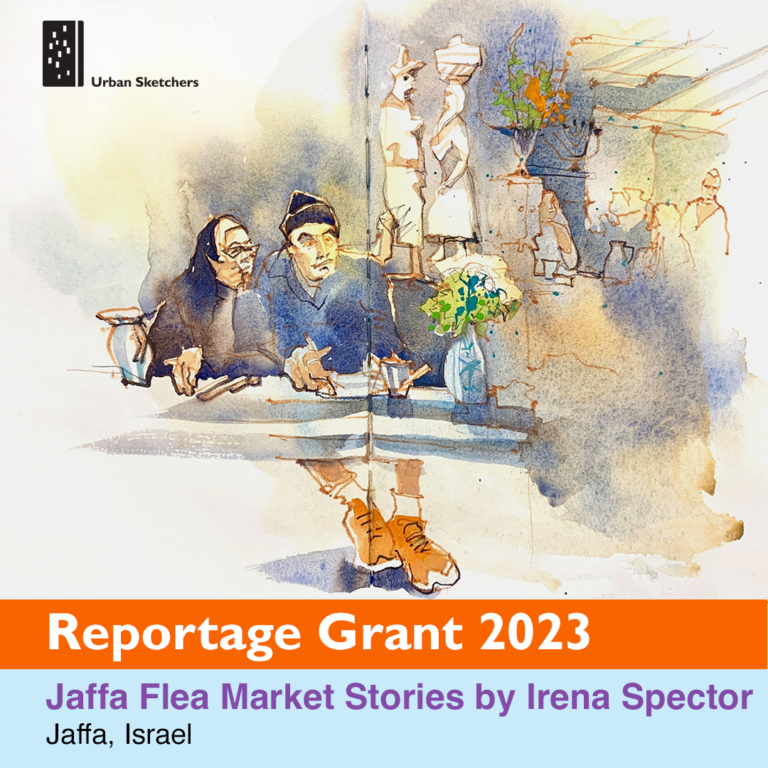
Recipient of the USK Reportage Grant, Irena Spector embarked on a journey to document the vibrant narratives of Jaffa Flea Market in Israel. Initially capturing its lively hues, the outbreak of war transformed her reportage. Beyond mere sketches, it became a beacon of solace amid uncertainty. Through her art, Spector beckons us to explore the market’s rich tapestry, offering glimpses of its ever-evolving essence, past, and present.
Engaging with people from all walks of life
Irena captures the vibrant personalities of the Jaffa Flea Market, from Rami Girma, a homeless man passionate about は ancient Akkadian language, to seasoned traders like Reuven and Asher, who share nostalgic tales. Through her sketches, she offers us a glimpse into the rich tapestry of individuals that define the market’s atmosphere.
A personal connection to a place in flux
Irena’s reportage is also a reflection of her personal connection to the place. With honesty and openness, with vibrant lines and atmospheric colors, she portrays the joy and sorrow that permeate the market, particularly during times of change. As war descended upon the region on October 7th, the market underwent a profound transformation.
Despite the challenges and uncertainties, Spector finds solace in the market and her art. As she navigates the joys and sorrows of life, she turns to sketching as a means of coping and finding comfort amidst the chaos, visible in this reportage.
Through her project, “Jaffa Flea Market Stories,” Irena offers viewers a poignant reflection on the fleeting nature of life and the enduring resilience of the human spirit.
Or as she puts it herself:
“In conclusion, I contemplated the fluidity of life, grateful for the opportunity to document the market’s dynamics. Much like the flea market itself, the report doesn’t end with a full stop, acknowledging that life goes on amidst ever-changing surroundings.”
To save a river by Niloufer Wadia
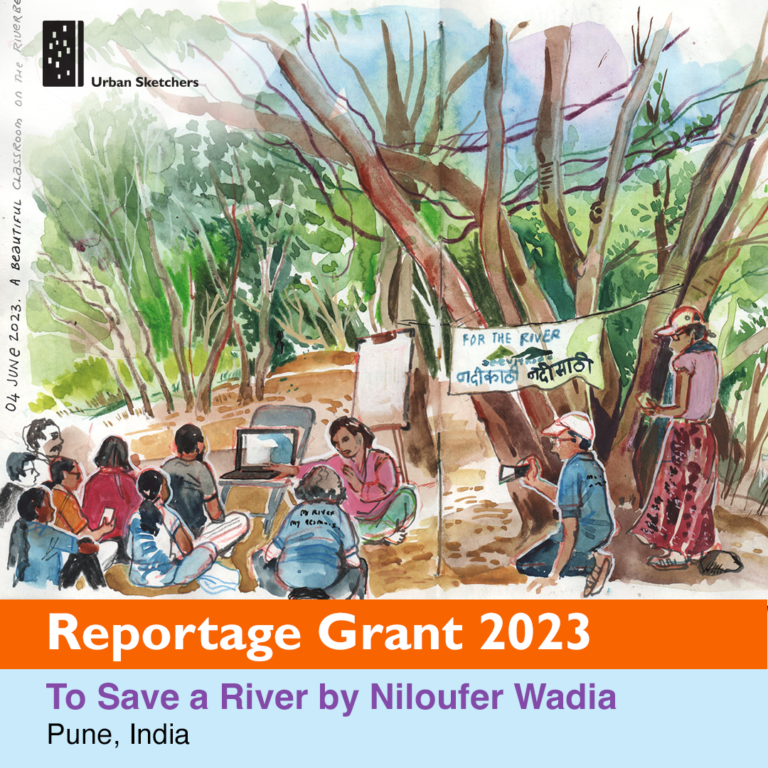
In the heart of Pune, India, artist Niloufer Wadia embarked on a remarkable sketching expedition that intertwines art with activism. Her project, “To Save a River,” for which she received a USK Reportage Grant, is not just about capturing scenes; it’s about documenting a citizen movement striving to revive a dying river.
From an engaged parent…
Wadia’s journey began as a parent accompanying her daughter on a community service project with a local NGO, Jeevitnadi, which aims to raise awareness about the deteriorating condition of rivers in Pune. Sitting by the tranquil riverside, Wadia’s eyes were opened to the profound impact of environmental degradation on her city’s waterways. Inspired by the dedication of the citizens she encountered, Wadia picked up her sketchbook and embarked on a mission to capture the essence of this grassroots movement.
The project unfolds like a sketch-essay, revealing the multifaceted challenges faced by the Mula River and the relentless efforts of citizens to reclaim its glory. Wadia’s sketches portray the stark reality of a river choked by hyacinth and sewage, juxtaposed with the hope and determination of those fighting for its revival. Through her artwork, Wadia sheds light on the detrimental impact of unplanned development and pollution, urging viewers to reflect on the consequences of environmental neglect.
… to a sketching warrior
Beyond the strokes of her pen, Wadia’s sketches capture the spirit of individual citizens, from young volunteers to dedicated seniors like Sneha Shah and Shailaja Deshpande, who tirelessly work towards a cleaner future. As Wadia navigates through protest marches and cleanup drives, her sketches serve as a reminder of the power of collective action, igniting hope and inspiration.
Through documenting, by video and by sketching, the reportage project “To Save a River,” becomes a voice for change and a beacon of hope for Pune’s riverscape. Wadia’s sketches not only celebrate the beauty of the river but also ignite a sense of urgency to protect and preserve it for generations to come.
